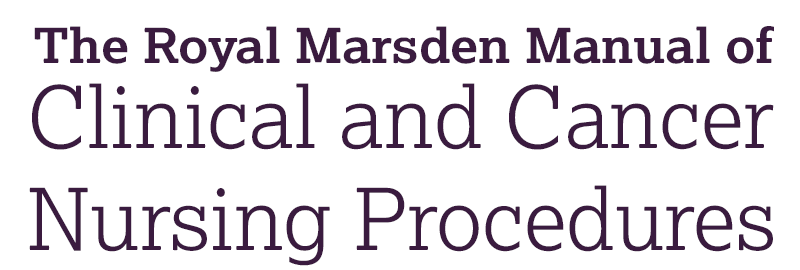Chapter 26: Acute oncology
Skip chapter table of contents and go to main content
Major artery rupture
Definition
Carotid artery rupture (CAR) is an acute major bleed with major cardiovascular manifestations, whose origin is the carotid artery in the neck (Upile et al. [295]). The term ‘sentinel’ or ‘herald’ bleed is defined as prodromal bleeding occurring 24–48 hours before the rupture of an artery that resolves either spontaneously or with packaging or pressure (Harris and Noble [104]). Carotid artery blowout is a rupture of the carotid artery or branches caused by the tumour mass compromising the vascular axis or by chemoradiation therapy (Casey [31], Peguero et al. [225]).
Anatomy and physiology
The common carotid arteries arise from the aorta on the left and from the brachiocephalic artery on the right, and they supply almost all the blood to the head and neck. They run upwards on either side of the trachea and divide at the level of the hyoid bone into the internal and external carotids. It is at this bifurcation that there is an area of increased risk of damage due to the thinness of the arterial wall (Casey [31], Shumrick [271]). There are three distinct layers to an artery: the outermost layer (adventitia) protects the artery and is nourished by the vasa vasorum which provides 80% of the nutrition to the arterial wall (Schiech [266]). When this essential nourishment is interrupted, destruction of the arterial wall occurs over 6–10 days (Lesage [142]).
Related theory
Studies show that CAR can occur in 3–4% of all patients who have undergone head and neck surgery (Koch [134], Lesage [142], Morrissey et al. [188]). However, in advanced disease CAR can account for over 11.6% of head and neck cancer deaths (Shedd and Shedd [270]). Haemorrhage may occur either externally from the neck, internally from within the oropharynx or directly into the airway or tracheostomy. Hypovolaemic shock is often the cause of death (Kane [124]), however asphyxiation from blood may also be a contributory factor. CAR can be dramatic and some preparation for the event is essential (Feber [74], Gagnon et al. [90], Kane [124]). This event needs immediate action and can be traumatic for all those involved.
There are several risk factors such as previous surgery, radiotherapy, post‐operative healing problems, pharyngocutaneous fistula, fungating tumour invading the artery and some pre‐existing medical conditions (Frawley and Begley [84]).
- Previous surgery. Any patient who has undergone head and neck surgery to sites local to the carotid artery is a potential candidate for a major bleed (Casey [31], Cohen and Rad [42]). Life‐threatening haemorrhage is a well‐recognized complication following a radical neck dissection (Rodriguez et al. [253]). A radical neck dissection removes the sternomastoid muscle and internal jugular vein and often involves sacrifice of the accessory nerve. This is done to rid the neck of lymph nodes that may contain metastatic tumour cells. Skin flaps in the neck are raised to expose the deep cervical fascia. The fascia is also dissected from the internal jugular vein, vagus nerve and carotid artery. Surgical interventions of this nature increase the risk of CAR occurring, especially if the adventitial arterial wall is exposed and removed due to tumour infiltration, and if there are subsequent wound healing complications, infection (Nieto et al. [211]) and previous irradiation to the area (Cohen and Rad [42]). Please note if the patient has had surgery, it is crucial that their resuscitation status is clarified.
- Radiotherapy. Previous neck irradiation is the most common factor leading to CAR (Kane [124], Rodriguez et al. [253]). Almost 100% of CARs occur within an irradiated field, especially if the treatment is delivered within 2 months of surgery (Nieto et al. [211]). Irradiation has been associated with a seven‐fold increase in the risk of CAR in patients with head and neck cancer (Cohen and Rad [42]).
- Post‐operative healing problems. Impaired wound healing can occur following surgery to the neck such as a radical neck dissection (Feber [74]). Deficits in circulation, oxygen and nutrients can all affect wound healing. If wound breakdown occurs this can have disastrous consequences. The carotid artery can be exposed and flap necrosis can occur, allowing the invasion of bacteria and leading to possible sepsis and desiccation of the adventitia (Cohen and Rad [42], Lesage [142], Nieto et al. [211]).
- Pharyngocutaneous fistula. Pharyngocutaneous fistula can occur as a result of wound breakdown following surgery and is recognized as an important causative factor in CAR (Feber [74], Nieto et al. [211]). The fistula results in the adventitia being bathed in saliva, which is bacteria laden and damaging to the outer lining of the arterial wall (Casey [31], Nieto et al. [211]).
- Fungating tumour invading the artery. Direct infiltration by the tumour can result in destruction of the arterial wall. A fungating wound will contain necrosis and often infected tissue, which only exacerbates the vulnerability of the arterial wall (Upile et al. [295]).
- Systemic factors. Pre‐existing medical conditions may also increase the risk of CAR. These are: diabetes mellitus and immune deficiencies (Johantgen [120]), generalized atherosclerosis (Nieto et al. [211], Schiech [266]) and malnutrition (Okamura et al. [220]). Age of 50 years and over and/or weight loss of 10–15% are also predisposing factors to CAR (Casey [31], Schiech [266]).
The management and care of the patient with an advanced malignancy in the head and neck demand much from the healthcare professionals involved. A CAR or carotid ‘blowout’ remains one of the most feared complications of head and neck cancer and its treatment (Cohen and Rad [42], Lovel [154]). The goal of care in the event of a patient with a CAR is to ensure death with dignity, providing a calm, reassuring and caring atmosphere, to minimize the distress, anxiety and fear felt by the patient and family and often the professionals involved (Frawley and Begley [85], Grahn et al. [95]).
Signs and symptoms
There are several signs and symptoms that should prepare the nurse for an imminent major bleed. It must be remembered, however, that there may be no warning at all in some cases and an assessment of risk factors must always be taken into consideration.
- ‘Sentinel’ or ‘herald’ bleeds can present as minor bleeding from a wound, flap site, tracheostomy, or the mouth (Forbes [80], Lovel [154]). As the process of erosion is gradual, impending rupture of the artery may be recognized by sentinel bleeding (Macmillan and Struthers [157]). Even seemingly trivial bleeding may herald a CAR (Fortunato and Ridge [82]).
- Pulsations from the artery or tracheostomy or flap site (Casey [31], Kane [124]).
- Sternal or high epigastric pain several hours before rupture (Anon. [5]).
- ‘Ballooning’ of an artery (Casey [31], Luo et al. [156], Schiech [266]).
There may be other indicators that a patient is at high risk of a CAR, specifically, direct observation by the surgeon that the tumour is infiltrating the arterial wall at the time of surgery. There may also be indications through scanning of the head and neck area, for example with MRI scans. The multidisciplinary head and neck cancer meeting can be the ideal forum to identify those patients who are at risk (Frawley and Begley [84], [85], Grahn et al. [95]).
Pre‐procedural considerations
Preparing the patient
When to warn a patient and family that CAR might occur is difficult to judge. It must be remembered that, although patients and families have a ‘right to know’, there is also a corresponding ‘right not to know’ and that they should have the option of choosing how much information they want to be given. It is suggested that two healthcare professionals should be present when talking to the family and have discussed prior to the meeting exactly what might be said to the patient and relatives. An open and honest approach is the best way of helping the patient and family (Bildstein and Blendowski [19], Feber [74], Forbes [80], Johantgen [120]). For the patient and family who are unprepared, this will be a horrifying experience and the shock of the death can contribute to complex bereavement issues (Cherny et al. [36], Dickenson and Johnson [62]).
Many patients and families will have contemplated how the death will occur and in most cases haemorrhage may already be an unexpressed fear (Feber [74]). Contemplating the truth and knowing what to expect, what to do and how distress can be relieved can be helpful to the patient and family (Kane [124]). It may also help the patient and family to know that in the event of a massive carotid rupture there should be little pain and that death is usually very quick (Cohen and Rad [42]). The information should ensure that patients/relatives are aware that no resuscitation will take place and this should be clearly documented in the patient's medical and nursing notes. Decide with the family if they wish to stay with the patient in the event of a CAR and be respectful of their wishes. It is important to stress to the patient/relatives that they may change their minds at any time and opt for care at home or in the hospice setting if available. Explain to the family that they will be offered a follow‐up meeting to discuss the event, allowing them a chance to debrief. The family should be offered the support of the hospital relative support co‐ordinator.
It is important that all the multiprofessional team are prepared; at handover the patient who is at risk of a CAR and their resuscitation status should be highlighted. Where possible the patient should be nursed in a single room to avoid shock and distress to other patients and relatives, and the equipment required in the event of a rupture must be available (see Procedure guideline 26.1) (Feber [74]). CAR happens quickly and equipment must be to hand in order to minimize the distress, anxiety and fear felt by the patient and family and often professionals involved (Frawley and Begley [85], Grahn et al. [95], Schiech [266]).
Pharmacological support
The pharmacological management of major life‐threatening bleeding should involve the use of an appropriate sedative drug (e.g. midazolam) (Lovel [154]). In most cases an injection of 10 mg of midazolam will adequately sedate the patient. However, some patients may require further, larger doses of midazolam, for example patients on long‐term benzodiazepine therapy (Roodenburg and Davies [255]). The subcutaneous route should be used in patients without intravenous access, although the intravenous route should be used in patients with intravenous access. The onset of action for intravenous midazolam is 2–3 minutes, whereas the onset of action for subcutaneous midazolam is 5–10 minutes (Twycross et al. [291]). The only indication for the use of opioids in this situation is the concurrent presence of pain.





